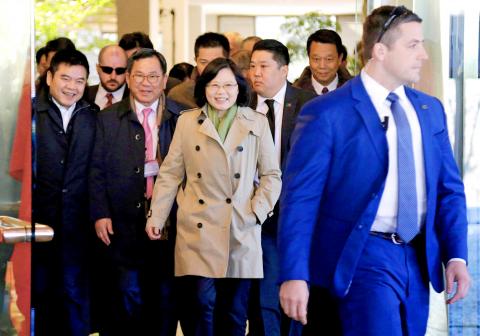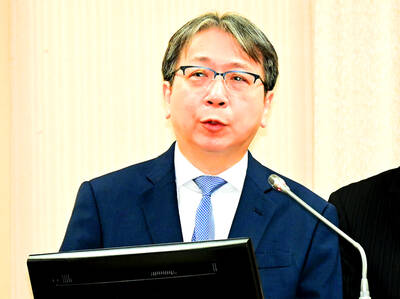President Tsai Ing-wen (蔡英文) on Saturday arrived in Houston for a brief transit stop on her way to Central America, a routine stopover that has been closely watched by Beijing after US president-elect Donald Trump spoke with her by telephone early last month.
Tsai touched down in Houston after setting out from Taiwan earlier in the day on her way to Honduras, the first leg of a nine-day trip. She is also to visit to Nicaragua, Guatemala and El Salvador, in that order.
Tsai was met at the airport by US Representative for Texas Blake Farenthold, American Institute in Taiwan Chairman James Moriarty and Taiwan’s Representative to the US Stanley Kao (高碩泰).

Photo: Reuters
The US Bureau of Diplomatic Security adopted high-level security measures for Tsai’s stopover.
When Tsai visited Houston’s Museum of Fine Arts, traffic controls were imposed, and police officers escorted her, while the museum was cleared for three hours.
Tsai also visited a Formosa Plastics Corp (台灣塑膠) facility in Point Comfort and a Nan Ya Plastics Corp (南亞塑膠) facility in Wharton. She was accompanied by Farenthold.
Tsai is scheduled to stay in Houston for one night after attending a dinner in her honor which is to be attended by several US officials, including Farenthold, US Representative for Texas Al Green, Moriarty and about 600 expat Taiwanese.
Moriarty was quoted by a Democratic Progressive Party legislator as saying that he would continue to promote good relations between Taiwan and the US, as the two nations share common values.
The Houston stop has taken on a new significance since Tsai’s telephone call with Trump last month. It was the first reported telephone call between a Taiwanese president and a US president or president-elect since 1979.
Tsai is scheduled to make a stopover in San Francisco on Jan. 13, after leaving El Salvador on her way back to Taiwan.
It is Tsai’s second overseas trip since taking office on May 20 last year. Tsai visited Panama in June last year.

The US government has signed defense cooperation agreements with Japan and the Philippines to boost the deterrence capabilities of countries in the first island chain, a report by the National Security Bureau (NSB) showed. The main countries on the first island chain include the two nations and Taiwan. The bureau is to present the report at a meeting of the legislature’s Foreign Affairs and National Defense Committee tomorrow. The US military has deployed Typhon missile systems to Japan’s Yamaguchi Prefecture and Zambales province in the Philippines during their joint military exercises. It has also installed NMESIS anti-ship systems in Japan’s Okinawa

TRAGEDY STRIKES TAIPEI: The suspect died after falling off a building after he threw smoke grenades into Taipei Main Station and went on a killing spree in Zhongshan A 27-year-old suspect allegedly threw smoke grenades in Taipei Main Station and then proceeded to Zhongshan MRT Station in a random killing spree that resulted in the death of the suspect and two other civilians, and seven injured, including one in critical condition, as of press time last night. The suspect, identified as a man surnamed Chang Wen (張文), allegedly began the attack at Taipei Main Station, the Taipei Fire Department said, adding that it received a report at 5:24pm that smoke grenades had been thrown in the station. One man in his 50s was rushed to hospital after a cardiac arrest

ON ALERT: Taiwan’s partners would issue warnings if China attempted to use Interpol to target Taiwanese, and the global body has mechanisms to prevent it, an official said China has stationed two to four people specializing in Taiwan affairs at its embassies in several democratic countries to monitor and harass Taiwanese, actions that the host nations would not tolerate, National Security Bureau (NSB) Director-General Tsai Ming-yen (蔡明彥) said yesterday. Tsai made the comments at a meeting of the legislature’s Foreign Affairs and National Defense Committee, which asked him and Minister of National Defense Wellington Koo (顧立雄) to report on potential conflicts in the Taiwan Strait and military preparedness. Democratic Progressive Party (DPP) Legislator Michelle Lin (林楚茵) expressed concern that Beijing has posted personnel from China’s Taiwan Affairs Office to its

PUBLIC SAFETY: The premier said that security would be tightened in transport hubs, while President Lai commended the public for their bravery The government is to deploy more police, including rapid response units, in crowded public areas to ensure a swift response to any threats, President William Lai (賴清德) said yesterday after a knife attack killed three people and injured 11 in Taipei the previous day. Lai made the remarks following a briefing by the National Police Agency on the progress of the investigation, saying that the attack underscored the importance of cooperation in public security between the central and local governments. The attack unfolded in the early evening on Friday around Taipei Main Station’s M7 exit and later near the Taipei MRT’s Zhongshan